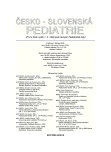-
Medical journals
- Career
Fetomaternal Haemorrhage as a Cause of Severe Neonatal Anaemia
Authors: B. Zoľáková; I. Krausová; K. Maťašová
Authors‘ workplace: Neonatologická klinika JLF UK a UNM, Martin prednosta prof. MUDr. M. Zibolen, CSc.
Published in: Čes-slov Pediat 2010; 65 (10): 580-583.
Category: Case Report
Overview
Authors present a case report of a newborn with severe anemia caused by fetomaternal haemorrhage. The mother with muscle dystrophy came to the delivery room with the perception of decreased fetal movements. Pathological cardiotocogram was the indication for urgent ceasarean section in the 36th gestation week. After delivery the complete resuscitation was needed. Severe anemia in the blood count required repeated transfusions of red blood cells. After exclusion of other causes of anemia, the reason for severe anemia in our patient was fetomaternal haemorrhage. It was confirmed by the presence of fetal hemoglobin in maternal blood.
Key words:
fetomaternal hemorrhage, newborn, anemia, fetal hemoglobin, prognosis
Sources
1. Blair JW, D’Alton ME. Fetomaternal hemorrhage. Obstet. Gynecol. 2010; 115(5): 1039–1051.
2. De Luca D, Pietrini D, Piastra M, et al. Successful resuscitation of unexpected neonatal hemorrhagic shock due to massive feto-maternal hemorrhage. Paediatr. Anesth. 2008; 18 : 1004–1006.
3. Dziegiel MH, Nielsen LK, Berkowicz A. Detecting fetomaternal hemorrhage by flow cytometry. Curr. Opin. Hematol. 2006; 13 : 490–495.
4. Friszer S, Cortey A, Pierre F, et al. Using middle cerebral artery peak systolic velocity to time in utero transfusions in fetomaternal hemorrhage. Obstet. Gynecol. 2010; 115(5): 1036–1038.
5. Hincz P, Brot A, Podchiechovski L, et al. Massive fetomaternal hemorrhage-case report. Ginekol. Pol. 2006; 77(6): 468–471.
6. Markham AL, Charscha DS, Perelmuter B. Case report of massive fetomaternal hemorrhage and a guidline for acute neonatal management. Advances in Neonatal Care 2006; 6(4): 197–207.
7. Pelikan DM, Scherjon SA, Mesker WE. Quantification of fetomaternal hemorrhage: A comparative study of the manual and automated microscopic Kleihauer-Betke tests and flow cytometry in clinical samples. Am. J. Obstet. Gynecol. 2004; 191 : 551–557.
8. Roberts DJ. Placental pathology, a survival guide. Arch. Pathol. Lab. Med. 2008; 132 : 641–651.
9. Rubod C, Deruelle P, Le Goueff F, et al. Prognosis for infants after massive fetomaternal hemorrhage. Obstet. Gynecol. 2007; 110 : 256–260.
10. Sifakis S, Koukoura O, Konstantinidou AE. Sonographic findings in severe fetomaternal transfusion. Arch. Gynecol. Obstet. 2010; 281(2): 241–245.
11. Thomas A, Mathew M, Moral E, et al. Acute massive fetomaternal hemorrhage: case reports and review of the literature. Acta Obstet. Gynecol. Scand. 2003; 82 : 479–480.
12. Votino C, Mirlesse V, Gourand L, et al. Successful treatment of a severe second trimester fetomaternal hemorrhage by repeated fetal intravascular transfusions. Fetal Diagn. Ther. 2008; 24(4): 503–505.
Labels
Neonatology Paediatrics General practitioner for children and adolescents
Article was published inCzech-Slovak Pediatrics

2010 Issue 10-
All articles in this issue
- Specific Aspects of Selected Sleep Disorders in Childhood
- Prenatal Effects of Alcohol
- Treatament of Tobacco Dependence – New, Important and Difficult Medical Topic
- Some Controversies in Gynecology and Obstetrics
- Prophylaxis of Early-onset Streptococcal Sepsis in Newborn Infants
- Hospitalization of Children for Bronchiolitis in Slovakia in 1996–2006
- Importance of Molecular Genetic Analysis for Diagnosis and Genetic Counseling in Families with Hyperammonemia and Ornithine carbamoyltransferase Deficiency
- Fetomaternal Haemorrhage as a Cause of Severe Neonatal Anaemia
- Procedural Pain in the Newborn: Possible Prevention and Mitigation
- The Problems of Short Frenulum
- Czech-Slovak Pediatrics
- Journal archive
- Current issue
- Online only
- About the journal
Most read in this issue- The Problems of Short Frenulum
- Prenatal Effects of Alcohol
- Prophylaxis of Early-onset Streptococcal Sepsis in Newborn Infants
- Fetomaternal Haemorrhage as a Cause of Severe Neonatal Anaemia
Login#ADS_BOTTOM_SCRIPTS#Forgotten passwordEnter the email address that you registered with. We will send you instructions on how to set a new password.
- Career

